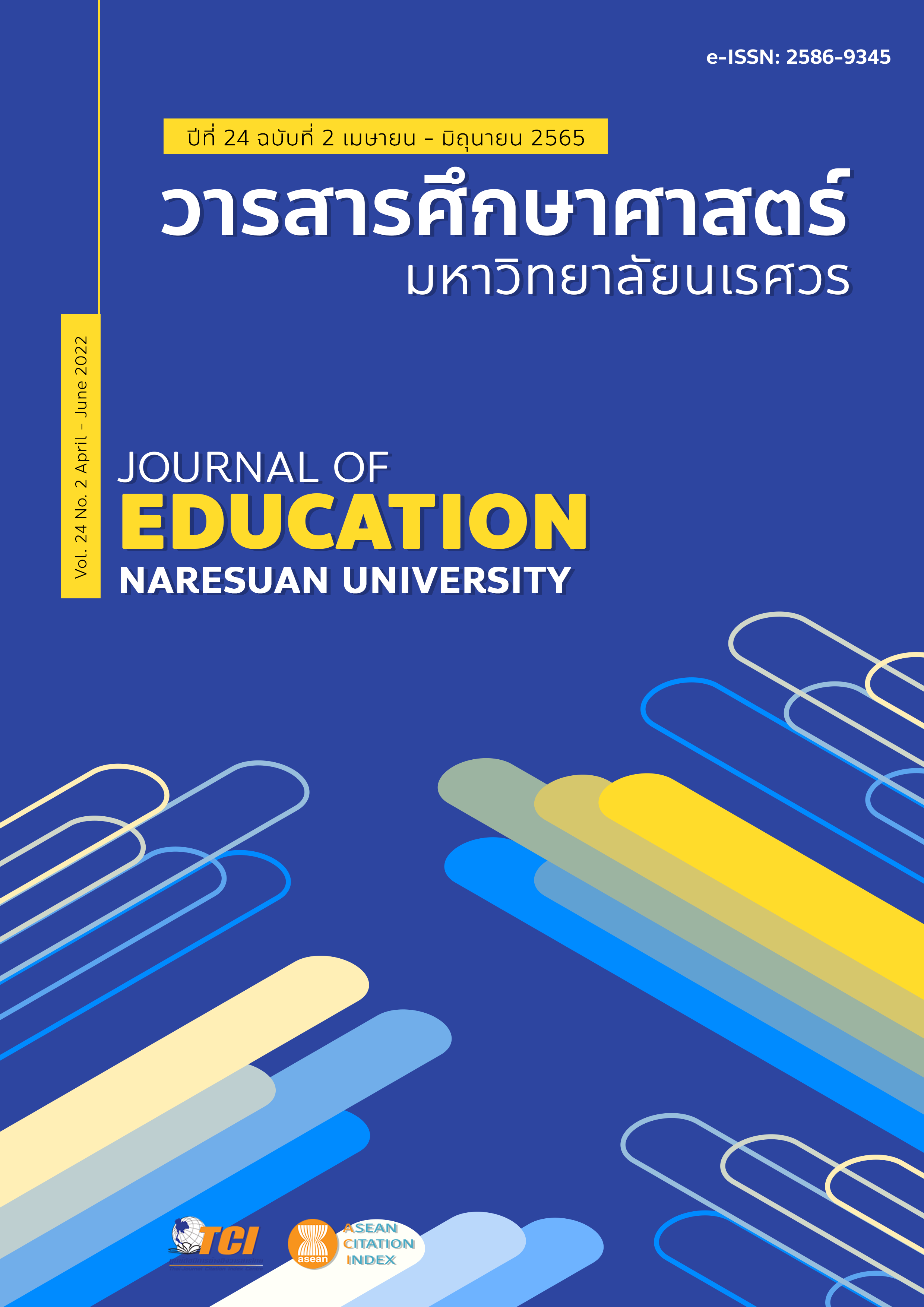CAUSAL RELATIONSHIP MODEL OF FACTORS AFFECTING STUDY-RELATED BURNOUT AMONG HIGH SCHOOL STUDENTS รูปแบบความสัมพันธ์เชิงสาเหตุของปัจจัยที่ส่งผลต่อภาวะหมดไฟในการเรียนของนักเรียนชั้นมัธยมศึกษาตอนปลาย
Main Article Content
Abstract
The Objectives of this research were to develop and examine a causal relationship model of factors affecting study-related burnout among high school students with the empirical data. The sample, selected by multi-stage sampling technique, consisted of 529 senior high school students. The data was collected by rating scale questionnaires, which are Study-Related Burnout Test, Academic Stress Test, School Engagement Test and Self-Expectation Test. The data were analyzed by structural equation modeling. The results of the research showed that:
1. The factors affecting of study-related burnout are academic stress, school engagement and self-expectation
2. The causal relationship model of factors affecting study-related burnout among high school students fitted the empirical data. The result are as follow; SRMR = .069, GFI = .935, CFI = .915. The model could describe the variance of study-related burnout in the percentage of 85.
3. The highest total negative effect and direct negative effect of the causal factor on study-related burnout of high school students was school engagement.
4. School engagement had indirect negative effect on study-related burnout through academic stress. Self-expectation had indirect negative effect on academic stress through school engagement.
Article Details

This work is licensed under a Creative Commons Attribution-NonCommercial-NoDerivatives 4.0 International License.
The owner of the article does not copy or violate any of its copyright. If any copyright infringement occurs or prosecution, in any case, the Editorial Board is not involved in all the rights to the owner of the article to be performed.
References
Aeamtussana, T., Prayai, N., Kamwachirapitak, R., & Yamsang, W. (2017). A causal model of personal and social factors on student engagement of senior high school students. Veridian E-Journal, Silpakorn University, 10(3), 52-67. [in Thai]
Bilge, F., Dost, T. M., & Cetin, B. (2014). Factors affecting burnout and school engagement among high school students: study habits, self-efficacy belief, and academic success. Educational Sciences: Theory & Practice, 14(5), 1721-1727. DOI: 10.12738/estp.2014.5.1727
Chiang Mai Provincial Education Office. (2019). Data of students/ students in each province in Chiang Mai, 2019. Retrieved September 14, 2019, from https://sites.google.com/view/infocmpeo62/ [in Thai]
Chupajit, W. (2017). Factors influencing the stress at work of inquiry official in the southernmost provinces (Master thesis). Songkhla: Hatyai University. [in Thai]
Demerouti, E., Mostert, K., & Bakker, A. B. (2010). Burnout and work engagement: A thorough Investigation of the Independency of both constructs. Journal of Occupational Health Psychology, 15(3), 209-222. DOI: 10.1037/a0019408
Friedman, G. (2014). Student, burnout and engagement (Master thesis). Johannesbure: University of the Witwatersrand.
Goffin, R. D. (2007). Assessing the adequacy of structural equation models: Golden rules and editorial policies. Personality and Individual Differences, 42, 831-839.
Hair, F. J., Black, C. W., Babin, J. B., & Anderson, E. R. (2014). Multivariate data analysis: Pearson new international edition. Harlow, United Kingdom.
Hochin, P. (2014). Factors affecting the academic stress of higher secondary school students at Ramkhamhaeng University Demonstration School (Master thesis). Bangkok: Ramkhamhaeng University. Bangkok. [in Thai]
Jimerson, S. R., Campos, E., & Greif, J. L. (2003). Toward an understanding of definitions and measures of school engagement and related terms. The California School Psychologist, 8, 7-27.
Jitraksa, N. (2006). Adolescence development. Chiang Rai: Chiang Rai Rajabhat University. [in Thai]
Kelloway, E. K. (2015). Using Mplus for structural equation modeling: A researcher’s guide. CA: Sage Publications.
Manikandan, K., & Neethu, A. T. (2018). Student engagement in relation to academic stress and self-efficacy. Guru Journal of Behavioral and Social Sciences, 6(1), 775-784.
Maslach, C., & Leiter, M. P. (1997). The truth about burnout: How organization cause personal stress and what to do about it. San Francisco, CA: John Wiley & Sons.
Puttarak, P. (2014). The relationship among family relationship and learning expectation, the effects of anxiety on learning and coping strategy of students in Songkhla Rajabhat University (Research report). Songkhla: Songkhla Rajabhat University. [in Thai]
Ruengtip, P. (2003). The effects of work stress and job satisfaction on job burnout for traffic policemen in the Metropolitan Police Subdivision 8 (Master thesis). Bangkok: Rajabhat Institute Dhonburi. [in Thai]
Schumacker, R. E. & Lomax, R. G. (2010). A beginner’s guide to structural equation modeling (3rd ed.). New jersey: Lawrence Erlbaum Associates.
Srisongmueang, K. (2016). Influence of academic stress on academic burnout of clinical medical students, Faculty of Medicine, Chiang Mai University: Moderating role of perceived social support (Master thesis). Chiang Mai: Chiang Mai University. [in Thai]
Vroom, H. V. (1964). Work and motivation. New York: Wiley and Sons.
Wilaporn, S., & Moonsilp, W. (1990). Thriving on stress. Bangkok: Ton-or. [in Thai]
Wonglorsaichon, B. (2012). Strategies for enhancing school engagement of students from the results of SEM analysis: Development and implementation (Doctoral dissertation). Bangkok: Chulalongkorn University, Bangkok. [in Thai]


